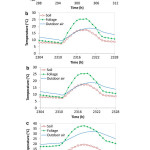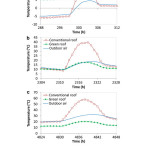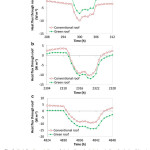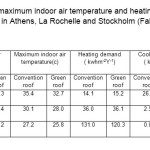Thermal Behavior of Green Roofs In Different Climates
Hamid Ahmadi1 * , Roozbeh Arabi2 and Leyla Fatahi2
1
Architecture Group, Art, Architecture & Urban Planning Department,
Islamic Azad University,
Isfahan,
Iran
2
Department of Architecture, Khomein Branch,
Islamic Azad University,
Khomein,
Iran
DOI: http://dx.doi.org/10.12944/CWE.10.Special-Issue1.110
Crisis of energy has been turned out into one of the large concerns in societies. One of the most effective solutions to reduce the energy consumption in buildings is green roof. Green roof is used as a passive technique in order to reduce the demand for cooling and heating energy in buildings and improve the quality of their surrounding conditions. In this paper, advantages of using green roofs were assessed and the findings of recent researches about the relationship between green roofs and energy consumption in buildings were reviewed. Results of reviewed studies show that thermal behavior of green roof is subject of different conditions like type and thickness of growing medium, leaf area index and density of vegetation, ceiling temperature transfer coefficient, R-value of roof, and climate of studied region. Finally, results of this study show that green roofs have a positive role in roof thermal behavior in different climates which the rate of their efficiency depends on the climate that they are located in.
Copy the following to cite this article:
Ahmadi H, Arabi R, Fatahi L. Thermal Behavior of Green Roofs In Different Climates. Special Issue of Curr World Environ 2015;10(Special Issue May 2015). DOI:http://dx.doi.org/10.12944/CWE.10.Special-Issue1.110
Copy the following to cite this URL:
Ahmadi H, Arabi R, Fatahi L. Thermal Behavior of Green Roofs In Different Climates. Special Issue of Curr World Environ 2015;10(Special Issue May 2015). Available from: http://www.cwejournal.org/?p=10179
Download article (pdf) Citation Manager Publish History
Select type of program for download
| Endnote EndNote format (Mac & Win) | |
| Reference Manager Ris format (Win only) | |
| Procite Ris format (Win only) | |
| Medlars Format | |
| RefWorks Format RefWorks format (Mac & Win) | |
| BibTex Format BibTex format (Mac & Win) |
Article Publishing History
| Received: | 2014-11-20 |
|---|---|
| Accepted: | 2015-12-30 |
Introduction
Combining plants with architecture, even roof gardens are not a new idea. Ancient people have benefited from the physical properties of soil and vegetation to make their houses cool in Africa and kept their houses warm in Europe. However, word “green roof and wall “is an unfamiliar expression for many people in Iran and even many specialists have not enough insight and awareness of it. Moss, lichen, grass have been observed in buildings in different geographical locations of Iran, especially Azerbaijan, Guilan, Mazandaran, roofs of mountainous houses and villages. The very outstanding sample is green roofs of rural houses in Masuleh that forms flower beds on roofs of lower houses which are actually yards of upper houses (Karimzadeh et al., 2011). Early 20th century can be known as trigger of a new wave to use roof or balcony as functional space. Le Corbusier and Frank Lloyd Wright were from the first modern supporters to use roof and balcony as green and functional spaces. As a matter of fact, none of these architects had any idea of infinite environmental, social and economic advantages of green roofs. Roof was merely a functional space and its definition was totally different from the new concept of green roof. Since early 1960s and by emphasizing on environmental quality in urban context and environmental challenges of metropolises such as air pollution, shortage of urban greenery system especially in CBDs (central business districts), advent of urban heat island and crisis of energy, the designers started to use green roofs by their new concept due to their environmental benefits and as an ecological solution in northern Europe and very fast they became widespread in most cities of European countries. Germany, Switzerland, France and Austria were pioneers and started extensive activities in this field. In 1980s, German cities were the subject of green roofs development in urban scale as its annual growth gets to 15 to 20 percent. Only in 1996, 10.000.000 m2 of green roofs were built in Germany (Sajadzadeh et al., 2014).
Specifications of Green Roofs
A green roof is a roof which a part or all of it is covered with vegetation and growing medium or cultivation environment. Green roof is in fact a roof that plants grow on its surface. Plant diversity of such a structure could be from a roof covered with artificial grass to roof garden that has been covered with plants cultivated in a park. Green roofs need plants that can resist against rough and harsh environment of roofs cape in conditions of drought, freezing and storm. Type of chosen plants is different depending on climate and territorial conditions.
Green roof includes an integrated set of vegetation and suitable cultivation environment compatible with selected plant, a cloth filter and a drainage layer to discharge water, resistant membrane against growth of plants roots and a water-proof insulation that covers final ceiling (Aein et al.,2013). Green roofs are divided into two main categories based on performance system, average height of growing medium and rate of required installations. These two categories are:
A-Extensive Green Roof System
this system is known as low – depth system with shallow thickness of growing medium. This type of roof just includes one or two types of plants and low – depth cultivation environment. Usually, this system is used when minimum dead load on the roof is considered. This type of roof is built on flat and steep roofs. Shallow- depth system has a depth of 60 – 200 mm and weight of 60 - 150 kg / m2 that additional cost is not imposed to maintain and irrigate (Razavian et al., 2011).
B–Intensive Green Roof System
this system is known as roof garden as well. Intensive roof systems need routine depth of growing medium in order to grow large plants and grasses. They usually have a depth between 150 to 1000 mm and a proximate weight between 180 – 500 kg / m2 and are able to support a wide diversity of plant species similar to a park on the ground. However, they have more maintenance cost. As well as two mentioned systems, there are two other secondary systems in green roofs category:
A-Semi–Intensive Green Roof System
this system is recognized as an average system (weight and structural features and maintenance cost, etc.)
B-Modular System or Planter Box
in this system, plants are cultivated and maintained in special boxes that cover all or most surface of green roof. The environment of modular system is not integrated (Aein et al.,2013). Table 1 provides a general comparison between the different specifications of green roofs.
Table 1: Comparison between the features of different types of green roof (Aein et al.,2013).
| Intensive | Semi-Intensive | Extensive | Parameter |
| A lot | Period | Low | The need for maintenance |
| Regularly | Period | Do not have | The need for irrigation |
| Perennial grasses, shrubs and trees | Greensward, plants and shrub | Moss, flower, plants and grass | Plants used |
| 150-400mm and more | 120-250mm | 60-200 mm | Depth building system |
| The above | Average | Down | Weight |
| Similar parks in the roof garden | Green roof design | Ecological protective layer | Operation |
Benefits of Green Roof
Green roofs have an effective role in solving the various environmental problems in building in urban scale. In addition to make an appeal environment, green roofs have many other benefits in comparison with conventional roofs, such as: run-off water management, reduction of air and noise pollution; green roofs increase the flora and fauna diversity in urban areas and they decrease the rate of carbon-dioxide emission in cities through converting the carbon dioxide into oxygen by photosynthesis process. Green roofs decrease the heat transfer through the ceiling which improves the energy efficiency in buildings. Green roofs impact the process of water cooling in chillers and improve the efficiency of HVAC systems through reduction of temperature around them in summers. This reduction also improves the efficiency of photovoltaic panels. In addition, green roofs increase the life span of insulation layer by limiting the heat tension in this layer. Finally, green roofs ameliorate the negative effects of urban heat island in urban scale. In table 2, the benefits of green roofs were summarized.
Table 2: Advantages of using urban green roofs (Issa et al., 2012).
| dimensions | Benefits |
| Ecological dimension | Keep biological diversity and create habitat, improvement of urban ecological - biological quality |
| Climatic dimension | Amelioration the negative effects of urban heat islandCooling effectReduction the effect of cold winds |
| Quality of urban environment | Improvement of air quality ( refinement of aerosols in air )Exchange of oxygen and carbon dioxideReduction of noise pollution
Run-off water management Increase of water quality and prevention of its pollution Reduction of electromagnetic radiation up to 99 % |
| Economical – cultural dimension | Reduction of artificial ventilation cost ( cooling in summers )Increase of insulation life spanImprovement the sense of space, recreation and health
Saving in energy consumption in winter through creating a natural insulation layer Creation of more green space |
Thermal Behavior of Green Roofs
In different studies, a comprehensive analysis of the effect of green roofs on thermal performance of buildings has been provided. Some of these analyses include: considering the heat flux of vegetation and growing medium layer, indoor temperature and energy demand. One of the most common types of research that exists in this field is the comparative study between the buildings covered by green roofs and conventional roofs while other building properties are similar (Issa et al., 2012)., (Wong et al., 2003)., [8],(Theodosiou,2003). Figures 1 to 3 show the thermal behavior of these structures in cold-humid climate. The results of these studies show that in cold seasons, the growing medium has higher temperature than surrounding air as a consequence of vegetation layer insulation. Meanwhile, in sunny days of cold season, growing medium has lower temperature than surrounding air due to evapotranspiration process of vegetation layer. On the other hand, in summertime, growing medium is always cooler than outdoor environment as a result of evapotranspiration process and insulation role of plants. In addition, results show that the mean temperature of vegetation layer is higher than surrounding air during the day and lower than surrounding air nocturnally. This phenomenon happens as a result of solar radiation absorption during the day and evapotranspiration process during the night.
Green roofs protect ceiling against solar radiation and heat fluctuations; green roofs are capable to reduce the fluctuation range up to 30°c. Figure2 shows the range and duration of fluctuations.
Another important effect of green roofs is the exchange of heat flux between ceiling and indoor environment. Figure 3 ( a, b ) shows that in wintertime, green roof is capable to decrease the heat loss up to 4 kw per hour which leads to less use of heating devices significantly. On the other hand, the passive cooling effect of green roofs in hot days of summertime is obvious (Figure 3 c). Overall heat loss through ceiling in a hot day of summer is almost three times more than a conventional roof which leads to cool indoor spaces significantly. Another research shows that green roofs absorb heat in hot summers of South-East Asia between 50 to 95 percent less than a conventional roof(Lin et al.2011).
 |
Figure 1: Soil and foliage surface temperatures during three typical days in the climate are mild and humid (Fahrli et al., 2012).:(a) Cold winter, (b) sunny winter, and (c) hot summer. Click here to View figure |
 |
Figure 2: Temperature of the exterior surface of the roof slab during three typical days in the climate is mild and humid(Fahrli et al., 2012).:(a) cold winter, (b) sunny winter, and (c) hot summer. Click here to View figure |
 |
Figure 3: Heat flux through the roof during three typical days in the climate is mild and humid(Fahrli et al., 2012).: (a) cold winter, (b) sunny winter, and (c) hot summer. Click here to View figure |
Energy Saving Through Green Roofs
Green roofs decrease the heat absorption through the ceiling which results in lower indoor temperature and improvement of thermal comfort for inhabitants. Data in table 3 clarifies that green roofs reduce the indoor mean temperature of residential buildings up to 2°c degree of internal temperature of residential buildings to 2 °c. In addition, studies show that green roofs have a negligible impact on energy consumption in cold seasons but on the other hand, they are able to reduce the cooling energy demand in summertime up to six percent which is a significant impact.
Table 3: Indoor air temperature for three typical in the climate is mild and humid (Fahrli et al., 2012).
| Maximum indoor air temperature(c) | Mean indoor air temperature(c) | Day | ||
| Green roof | Conventional roof | Green roof | Conventional roof | |
| 19.0 | 19.0 | 19.0 | 19.0 | Cold winter |
| 21.4 | 21.8 | 20.0 | 20.3 | Sunny winter |
| 28.0 | 30.1 | 26.4 | 28.4 | Hot summer |
Table 4: Heating, cooling, and total energy demand for conventional and green roofs in the climate is mild and humid(Fahrli et al., 2012).
| Total demand(kwhm-2Y-1) | Cooling demand(kwhm-2Y-1) | Heating demand(kwhm-2Y-1) | Roof type |
| 38.5 | 2.5 | 36.0 | Conventional |
| 36.2 | 0.1 | 36.1 | Green |
Many researches on energy saving through green roofs in different climates and different buildings have been conducted. Results show that the effect of green roofs on indoor temperature depends to a great extent on climate and building function (rate of energy consumption in building). For example, in an experiment in Athena, simulations showed that the required annual cooling energy for an administrative building was reduced almost 40 percent, while for a hotel covered with green roof, indoor mean temperature reduced around 2°c reduction and mean daily temperature degree decreased between 4 – 7°c(Alexandri E, Jones P., 2008).
The impact of Leaf Area Index
Previous studies prove that increase of leaf area index results in cooling energy demand. Main reason behind this phenomenon is the improvement of evapotranspiration process and shadow effect made by branches and leaves (Wong et al.2003). The leaf area index is one of the parameters that influences the thermal behavior in green roofs through the height of canopy and stomata resistance. It has an important effect on its thermal performance. Table 5 shows the effect of leaf area index on indoor temperature in buildings.
Table 5: Mean and maximum indoor air temperature and heating, cooling, and total energy demand in in the climate is mild and humid for different LAI levels (Fahrli et al., 2012).
| Energy demand( kwhm-2Y-1) | Indoor air temperature(c) | Roof type | |||
| Total | Cooling | Heating | Maximum | Mean | |
| 38.5 | 2.5 | 36.0 | 30.1 | 28.3 | Conventional |
| 35.6 | 0.2 | 35.4 | 28.3 | 26.6 | Green(LAI=0.5) |
| 36.2 | 0.1 | 36.1 | 28.0 | 26.3 | Green(LAI=2.0) |
| 36.3 | 0.1 | 36.2 | 27.9 | 26.2 | Green(LAI=3.5) |
| 36.4 | 0.1 | 36.3 | 27.9 | 26.2 | Green(LAI=5.0) |
Effect of Ceiling Insulation
Insulation results in reduction of green roofs cooling effect on indoor temperature. In residential buildings which have ceilings without insulation, green roofs are able to reduce indoor temperature up to 9. 3°, while in buildings with insulated ceilings, temperature reduction is less than1°c.
Previous researches show that the green roofs reduce the cooling energy demand in summer up to 48 percent. Reduction mainly is provided through the thermal resistance of green roofs. For the thickness more than 10 cm, the effect of green roofs on thermal flux is almost negligible. The effect of green roof on cooling demand decreases with the increase of insulation thickness. In conventional roof, when the thickness of insulation is more than 5 cm, the green roof doesn’t have any significant impact on thermal flux. Any additional insulation limits the cooling effect of green roofs. Finally, it seems logical that the effect of green roof on total required energy is reduced with increase of insulation.
Comparison of Green Roofs’ Impact on Air Temperature in Different Climatic Conditions
Comparative studies show that effect of green roofs on air temperature is more significant in hot climate. For instance, in a comparison study, it has been proved that the indoor mean air temperature reduced by using green roofs about 2.6, 2 and 1.4°c for Athena, La Rochelle and Stockholm, respectively.
Finally, it can be concluded that green roofs reduce the required energy in any three climatic conditions (Barrio, 1998), (Castleton et al., 2010), (Feng et al., 2010), (Kumar, R., & Kaushik, S., 2005), (Niachou et al., 2001), (Sailor, 2008).
 |
Table 6: Mean and maximum indoor air temperature and heating, cooling, and total energy demand in Athens, La Rochelle and Stockholm (Fahrli et al., 2012). Click here to View table |
Finally, it can be concluded that green roofs reduce the required energy in any three climatic conditions.(Barrio, 1998), (Castleton et al., 2010), (Feng et al., 2010), (Kumar, R., & Kaushik, S., 2005), (Niachou et al., 2001), (Sailor, 2008).
Conclusion
Green roofs reduce the indoor air temperature of buildings in summertime through three approaches: shading, evapotranspiration and insulation against solar radiation. Meanwhile, they act as a wind shield throughout cold seasons which leads to reduction of heating energy demand. However, their effect in winter is less than their effect in summer. Green roofs protect the ceiling against the scorching solar radiation and extensive heat fluctuations. Green roofs act as insulation elements which stabilize the indoor temperature. In general, green roof system is as an optimum solution which is suitable for different climates. Finally, it can be concluded that the green roofs decrease the energy demand in different climatic conditions. But this reduction to a great extent depends on climate, building function, the type of green roof and the insulation level of building.
References
- Karimzadeh, A. &Shahriari, Sh.(2011).Green roof new strategy on sustainable architecture. National Conference on Engineering and Sustainable Development. Branch Estahban.
- Sajadzadeh, h. Marzanpor, f. Green roof architecture is a new approach to reduce energy consumption. Second National Conference on climate, building and energy efficiency. The energy efficiency of iran. Iran. Esfahan. (2014).
- Aein, s.Kordafshar, m.Porfallah, h.(2013).The effect of green roofs on residential energy consumption of a building in a cold climate Tabriz. Second International Conference on new approaches to energy storage, Tehran, South Pars Special Economic Energy Zone.
- Razavian, m.t.GHafori, a.Razavian, m. Green roofs. Environment and spatial planning. Volume 3. Number 10. Fall 2011.137-160. (2011).
- Fahrli, d.Abdolahi, m.Valibeigi, m.(2012). Limiting factors in the development of green roofs on AHP. Ecology.Volume 37. Issue 60.Winter 2012.89-98.
- Issa Jaffal, Salah-Eddine Ouldboukhitine, Rafik Belarbi.(2012).A comprehensive study of the impact of green roofs on building energy performance"Renewable Energy 43
- Wong, N. H., Cheong, D., Yan, H., Soh, J., Ong, C., & Sia, A. (2003). The effects of rooftop garden on energy consumption of a commercial building in Singapore. Energy and buildings, 35(4), 353-364
- Wong, N. H., Chen, Y., Ong, C. L., & Sia, A. (2003). Investigation of thermal benefits of rooftop garden in the tropical environment. Building and environment, 38(2), 261-270
- Theodosiou, T. G. (2003). Summer period analysis of the performance of a planted roof as a passive cooling technique. Energy and buildings, 35(9), 909-917.
- Lin Y-J, Lin H-T. Thermal performance of different planting substrates and irrigation frequencies in extensive tropical rooftop greeneries. Build Environ 2011;46:345-55.
- Alexandri E, Jones P. Temperature decreases in an urban canyon due to green walls and green roofs in diverse climates. Build Environ 2008;43:480-93.
- Barrio, E. P. D. (1998). Analysis of the green roofs cooling potential in buildings. Energy and buildings, 27(2), 179-193
- Castleton, H., Stovin, V., Beck, S., & Davison, J. (2010). Green roofs; building energy savings and the potential for retrofit. Energy and buildings, 42(10), 1582-1591
- Feng, C., Meng, Q., & Zhang, Y. (2010). Theoretical and experimental analysis of the energy balance of extensive green roofs. Energy and buildings, 42(6), 959-965
- Kumar, R., & Kaushik, S. (2005). Performance evaluation of green roof and shading for thermal protection of buildings. Building and environment, 40(11), 1505-1511
- Niachou, A., Papakonstantinou, K., Santamouris, M., Tsangrassoulis, A., & Mihalakakou, G. (2001). Analysis of the green roof thermal properties and investigation of its energy performance. Energy and buildings, 33(7), 719-729
- Sailor, D. J. (2008). A green roof model for building energy simulation programs. Energy and buildings, 40(8), 1466-1478







